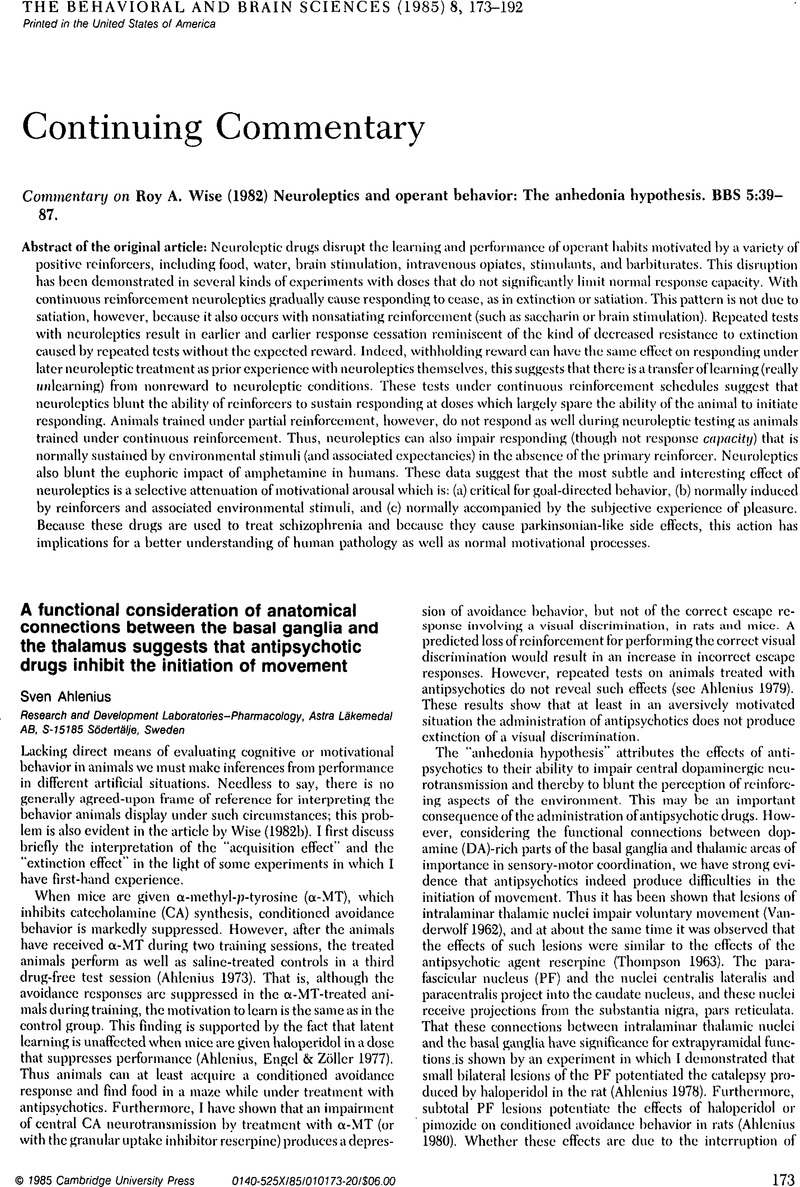Crossref Citations
This article has been cited by the following publications. This list is generated based on data provided by Crossref.
Wise, Roy A.
1987.
The role of reward pathways in the development of drug dependence.
Pharmacology & Therapeutics,
Vol. 35,
Issue. 1-2,
p.
227.
Colle, Lois M.
and
Wise, Roy A.
1987.
Opposite effects of unilateral forebrain ablations on ipsilateral and contralateral hypothalamic self-stimulation.
Brain Research,
Vol. 407,
Issue. 2,
p.
285.
Colle, Lois M.
and
Wise, Roy A.
1988.
Effects of nucleus accumbens amphetamine on lateral hypothalamic brain stimulation reward.
Brain Research,
Vol. 459,
Issue. 2,
p.
361.
Salamone, John D.
1988.
Dopaminergic involvement in activational aspects of motivation: Effects of haloperidol on schedule-induced activity, feeding, and foraging in rats.
Psychobiology,
Vol. 16,
Issue. 3,
p.
196.
WISE, ROY A.
1988.
Psychomotor Stimulant Properties of Addictive Drugs.
Annals of the New York Academy of Sciences,
Vol. 537,
Issue. 1,
p.
228.
Treit, Dallas
and
Berridge, Kent C.
1990.
A comparison of benzodiazepine, serotonin, and dopamine agents in the taste-reactivity paradigm.
Pharmacology Biochemistry and Behavior,
Vol. 37,
Issue. 3,
p.
451.
Hall, Frank S.
Stellar, James R.
and
Kelley, Ann E.
1990.
Acute and chronic desipramine treatment effects on rewarding electrical stimulation of the lateral hypothalamus.
Pharmacology Biochemistry and Behavior,
Vol. 37,
Issue. 2,
p.
277.
McCutcheon, N.Bruce
Rosellini, Robert A.
and
Bandel, Steven
1991.
Controllability of stressors and rewarding brain stimulation: Effect on the rate-intensity function.
Physiology & Behavior,
Vol. 50,
Issue. 1,
p.
161.
Salamone, J. D.
Steinpreis, R. E.
McCullough, L. D.
Smith, P.
Grebel, D.
and
Mahan, K.
1991.
Haloperidol and nucleus accumbens dopamine depletion suppress lever pressing for food but increase free food consumption in a novel food choice procedure.
Psychopharmacology,
Vol. 104,
Issue. 4,
p.
515.
McCullough, L. D.
and
Salamone, J. D.
1992.
Anxiogenic drugs beta-CCE and FG 7142 increase extracellular dopamine levels in nucleus accumbens.
Psychopharmacology,
Vol. 109,
Issue. 3,
p.
379.
McCullough, L.D.
Sokolowski, J.D.
and
Salamone, J.D.
1993.
A neurochemical and behavioral investigation of the involvement of nucleus accumbens dopamine in instrumental avoidance.
Neuroscience,
Vol. 52,
Issue. 4,
p.
919.
Salamone, John D.
Cousins, Michael S.
and
Bucher, Sherri
1994.
Anhedonia or anergia? Effects of haloperidol and nucleus accumbens dopamine depletion on instrumental response selection in a T-maze cost/benefit procedure.
Behavioural Brain Research,
Vol. 65,
Issue. 2,
p.
221.
Cousins, Michael S.
and
Salamone, John D.
1994.
Nucleus accumbens dopamine depletions in rats affect relative response allocation in a novel cost/benefit procedure.
Pharmacology Biochemistry and Behavior,
Vol. 49,
Issue. 1,
p.
85.
Cousins, Michael S.
Wei, Wei
and
Salamone, John D.
1994.
Pharmacological characterization of performance on a concurrent lever pressing/feeding choice procedure: effects of dopamine antagonist, cholinomimetic, sedative and stimulant drugs.
Psychopharmacology,
Vol. 116,
Issue. 4,
p.
529.
Salamone, John D.
1994.
The involvement of nucleus accumbens dopamine in appetitive and aversive motivation.
Behavioural Brain Research,
Vol. 61,
Issue. 2,
p.
117.
Baunez, C.
Nieoullon, A.
and
Amalric, M.
1995.
Dopamine and complex sensorimotor integration: Further studies in a conditioned motor task in the rat.
Neuroscience,
Vol. 65,
Issue. 2,
p.
375.
Berridge, Kent C.
1996.
Food reward: Brain substrates of wanting and liking.
Neuroscience & Biobehavioral Reviews,
Vol. 20,
Issue. 1,
p.
1.
Anisman, Hymie
Kokkinidis, L.
and
Merali, Z.
1996.
Interleukin-2 decreases accumbal dopamine efflux and responding for rewarding lateral hypothalamic stimulation.
Brain Research,
Vol. 731,
Issue. 1-2,
p.
1.
TOMIE, ARTHUR
1996.
Locating Reward Cue at Response Manipulandum (CAM) Induces Symptoms of Drug Abuse.
Neuroscience & Biobehavioral Reviews,
Vol. 20,
Issue. 3,
p.
505.
Cousins, M.S.
Atherton, A.
Turner, L.
and
Salamone, J.D.
1996.
Nucleus accumbens dopamine depletions alter relative response allocation in a T-maze cost/benefit task.
Behavioural Brain Research,
Vol. 74,
Issue. 1-2,
p.
189.


